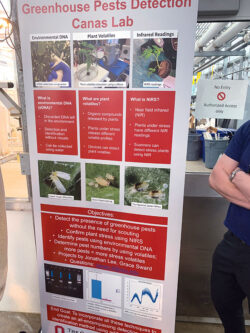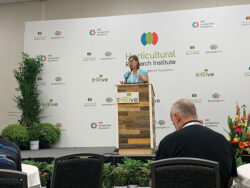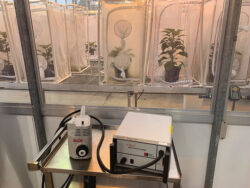
Features
Pest and disease management at Cultivate ‘23
A quick overview of this hot topic at one of the green industry’s biggest events
September 8, 2023 By Amy Kouniakis
Pest and disease management was a major topic of discussion at Cultivate 2023 in Columbus, OH, this past July. Panel discussions, information sessions and even the trade floor provided some much-needed insight and advice on a variety of issues growers face.
The following is a very brief overview of what’s new and what’s coming down the pipeline in the ongoing battle raging in greenhouses across North America.
Thrips parvispinus
This pest was clearly top of mind for many in attendance at Cultivate ’23 as the T. parvispinus has made its presence known across the continent.
A panel discussion, hosted by Quebec-based Lallemand, sought to reassure attendees that the industry is in a good place in terms of managing this pest.
“[This pest] can be managed with biocontrols and some pesticides,” said Lallemand Technical Lead, Matthew Krause, during the discussion. “This is not a death sentence.”
In the August 2023 issue of Greenhouse Canada, Dr. Sarah Jandricic, OMAFRA’s floriculture IPM specialist, even provided some stats on some of the products available to Canadian growers and their effect on knocking down the pest.
The panel at Cultivate ’23 emphasized the need for growers to accurately identify T. Parvispinus before setting about trying to eradicate it. Wrongful identification could result in using the wrong forms of control and causing more damage to plants, as well as increase the risk of pests developing a resistance to overapplied products.
Dr. Rose Buitenhuis, of Vineland Research and Innovation Centre, presented at the conference on the use of unrooted cutting dips for controlling an number of Thrips species, including the newest pest on the block. Her research has found that dips consisting of landscape oils and BotaniGard 22WP help reduce Thrips populations. The addition of biocontrols, Buitenhuis said, is the most optimal way to control this pest.
Perhaps the best news on this front to come out of Cultivate ’23, is that a Task Force, made up of experts from across all the industry, has been formed to further address the challenges of this pest.
Botrytis
Alongside Buitenhuis, Dr. James Faust, of Clemson University, was presenting on the latest in Botrytis management.

A poster outling the highlights of a master’s research project being carried out by Grace Sward at the Ohio Agriculture Research and Development Centre (OARDC) located at Ohio State University’s Wooster campus
Key takeaways from his presentation included the importance of correctly identifying the blight (because early signs of Botrytis on flower petals can be very similar to those caused by other pathogens). He also empahsized greenhouse sanitation and keeping a very close eye on moisture levels within the greenhouse. According to Faust, relative humidity of less than 94 per cent or lengthy periods of leaf wetness (more than 12 hours) can greatly increase a plant’s susceptibility to Botrytis spore germination.
Horizontal airflow fans, exhaust fans and ensuring the temperature in the greenhouse to above dewpoint to prevent condensation are some of the actionable steps growers can take to minimize spore growth.
More resources and information specific to Faust’s presentation, as well as Buitenhuis’, at Cultivate’23 can be found on the American Floral Endowment website.
In the meantime, Dr. Mohyuddin Mirza, a Canadian greenhouse specialist and long-time contributor to Greenhouse Canada, outlined some best practices for greenhouse sanitation in the August 2023 issue that could go a long way to preventing the spread of pathogens like Botrytis, but could also improve crop performance as a whole.
Research study
As part of the Cultivate’23 experience, a tour of the Ohio Agriculture Research and Development Centre located at Ohio State University’s Wooster campus, invited attendees into the greenhouses where some fascinating research is taking place.

Dr. Rose Buitenhuis, of Vineland Research and Innovation Centre, presented at Cutlivate ‘23 on the use of dips for Thrips.
Dr. Michelle Jones, who teaches horticulture and crop science at OSU, led groups through the school’s state-of-the-art facility and facilitated conversations around some of the undergraduate research taking place there.
Some of the projects there were at looking things like microbial biostimulants and pH balance, as well as phosphorus uptake and possibilities for its reduction throughout the production process (more on which we hope to run in future issues of this magazine).
On the pest management end of things, one project stood out. The work, being carried out by masters student Grace Sward, is looking at monitoring plant stress through environmental DNA, nearfield infrared (NIR) as well as measuring plant volatiles (organic compounds released by plants). When combined, the theory is that the collected data can be used towards much earlier pest detection and ultimately, better management of the problem.
Sward’s project focusses on Sweet Potato Whiteflies, Green Peach Aphids and Two-Spotted spidermites on a poinsettia crop.
The goal of the project is to finds ways to detect the presence of pests without the need for scouting. Essentially using AI for earlier, more exact detection and identification. The project is still in its early stages but has tremendous potential for being a game-changer for growers.
At the nearby Seacrest Arboretum, which was also a stop on the tour of the campus, further research is being carried out in the gardens on blight resistance and pest management on various crops (including crab-apples, hydrangea and various rose cultivars).
Seacrest is a 100-acre ‘laboratory of plants,’ according to the garden’s curator, Jason Veil. It is located on the former Gardens of Legend and Romance, which was decimated several years ago by a blight affecting the garden’s roses. Today, it is a trialing and research garden that remains open to the public.
More information on the OSU OARDC and Seacrest Arboretum and the research coming out of there can be found on the OSU website.
Technology and automation
As mentioned above, AI applications will play a huge role in pest and disease management in the years to come. One area in particular that got a lot of attention at Cultivate this year is the use of drone technology in monitoring and even knocking down potential pests.

One of the tools being used to monitor plant volatiles at the OARDC research greenhouse in Wooster, OH.
Three separate and very well-attended sessions discussed the latest in drone technology and its use in the horticultural sector. As it stands, this is a technology that is being used outside of the greenhouse with great success but more research is being done on how drones can safely and effectively be used indoors. For growers who make use of outdoor growing spaces, this is a technology you want to be paying close attention to.
When it comes to drones, accuracy is the name of the game. In field trials, the drone’s ability to zero in on where the problem is and to deploy the necessary biocontrols within very precise parameters is astonishing.
Stanton Gill, IPM specialist and Professor of Landscape Technology Program at Montgomery College in Maryland, presented the results of two years of successful field trials where drones were used to apply systemic insecticides in outdoor greenhouse crops. Much of his work, including several books written on pest management and technology, can be found online.
One thing to keep in mind, this technology is still evolving alongside legislation. Also, the operation of this technology should be carried out by those trained in its usage. Rest assured, however, the drones are coming and will have a big role to play in the battle against pest and disease in the greenhouse.
Resources for Canadian greenhouse growers:
- Ontario Ministry of Agriculture, Food and Rural Affairs (OMAFRA) – https://omafra.gov.on.ca
- Quebec Ministry of Agriculture, Fisheries, and Food (MAPAQ) – https://www.mapaq.gouv.qc.ca
- British Columbia Greenhouse Growers’ Association (BCGGA) – https://bcgreenhouse.ca/
- Canadian Food Inspection Agency (CFIA) – https://inspection.canada.ca/
- Pest Management Regulatory Agency (PMRA)
https://www.canada.ca/en/health-canada/corporate/about-health-canada/branches-agencies/pest-management-regulatory-agency.html - Canadian Greenhouse Growers’ Directory (Flowers Canada Growers)
https://www.flowerscanadagrowers.com/flower-growers/canadian-greenhouse-growers-directory - Vineland Research and Innovation Centre – https://www.vinelandresearch.com/
- Fruit and Vegetable Growers of Canada – https://fvgc.ca/
- Canadian Ornamental Horticulture Alliance (COHA) – https://coha-acho.ca/
Editor’s note: Pest management practices may vary depending on the region. It’s always a good idea to consult with local experts and professionals to tailor the pest management approach to your specific greenhouse situation.
Print this page